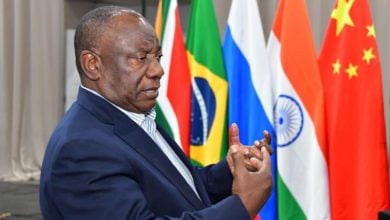On April 8, Barack Obama and Russian President Dmitry Medvedev signed the new Strategic Arms Reduction Treaty in Prague.
 August 6, 1945: First U.S. atomic bombing of Japan, on Hiroshima Photo: National Geographic |
In his speech at the signing, President Obama projected a sentiment of good will toward the peoples of the world and called for an end to nuclear aggression—at the same time making it clear to Iran and North Korea that they continue to be in the nuclear crosshairs of the United States.
In particularly thuggish remarks on April 7, Secretary of “Defense” Robert Gates threatened: “If there is a message for Iran and North Korea here, it is that if you’re going to play by the rules, if you’re going to join the international community, then we will undertake certain obligations to you.
“But if you’re not going to play by the rules, if you’re going to be a proliferator, then all options are on the table in terms of how we deal with you.” (AFP)
Translation of “all options are on the table”: If the Iranian and North Korean governments don’t bow to U.S. demands, they may be the targets of military attack, including the first-strike use of nuclear weapons.
So what exactly does the new START agreement accomplish in terms of real arms reduction? Actually, very little.
Ninety percent or more of the world’s nuclear weapons are held by the United States and Russia. And Hans Kristensen of the Federation of American Scientists points out: “[W]hile the treaty reduces the legal limit for deployed strategic warheads [by the United States and Russia], it doesn’t actually reduce the number of warheads. Indeed, the treaty does not require destruction of a single nuclear warhead and actually permits the United States and Russia to deploy almost the same number of strategic warheads that were permitted by the 2002 Moscow Treaty.”
Moreover, Kristensen continues, “These limits don’t have to be met until 2017, and will remain in effect for three years until the treaty expires in 2020 (assuming ratification occurs this year).” (FAS Strategic Security Blog)
So if you were hoping that this treaty meant a world safe from nuclear weaponry, you would be sadly disappointed. The remaining armaments can still easily achieve complete global devastation.
President Obama also portrayed as a major step toward “nuclear security” this decision, announced at the signing: “Earlier this week, the United States formally changed our policy to make it clear that those nuclear-weapons states that are in compliance with the Nuclear Non-Proliferation Treaty and their non-proliferation obligations will not be threatened by America’s nuclear arsenal.”
A major aim of the non-proliferation treaty is to preserve a monopoly of nuclear weapons by the existing nuclear powers—with the lion’s share being held by the United States, the only country to ever use nuclear weapons—while ostensibly allowing any signatory to develop nuclear technology for peaceful purposes.
Iran and North Korea still under threat
In fact, however, any country following an independent path of development, whether on a capitalist or socialist basis, and whether it has formally signed and adhered to the NPT or not, continues to be under threat of nuclear attack by the United States. Such countries are effectively banned from even developing the capability of enriching uranium for nuclear power generation, not to mention developing nuclear weapons for self-defense against imperialist attack.
Despite his announcement of the supposed change in policy, President Obama made it clear that he fully intended to carry on the long-standing U.S. policy of undermining Iran’s right to self-determination:
“[W]e will not tolerate actions that flout the NPT, risk an arms race in a vital region, and threaten the credibility of the international community and our collective security,” he said, referring to Iran.
Never mind that Iran has not “flouted” the NPT and is not building nuclear weapons. It continues to enrich uranium for nuclear power generation and medical uses, which is completely legal under the NPT. It also continues to follow an independent path of development and a foreign policy that is not subservient to U.S. wishes. And so despite Obama’s supposed change in policy, Iran continues to be subject to economic sanctions and “threatened by America’s nuclear arsenal.”
Reflecting its independent stance, Iran has announced it will hold a “denuclearization conference” April 17-18 under the banner “Nuclear energy for all, nuclear arms for none.” Officials from more than 60 countries as well as representatives from various international and non-governmental entities have been invited to attend. (PressTV.com)
North Korea, for its part, withdrew from the NPT in January 2003 following failure of the United States to live up to a previous agreement to provide alternative energy sources. It has been forced to develop a nuclear deterrent against constant threats from the United States and U.S.-occupied South Korea, including, as President Obama implied, the threat of a nuclear first strike.
With all this in mind, the truth behind the new START agreement becomes clear. It is not to create a world safe from nuclear weapons. It is rather to legitimize the United States as a state trying to rid developing countries of nuclear weapons and the means of producing them while maintaining its own nuclear capabilities.






